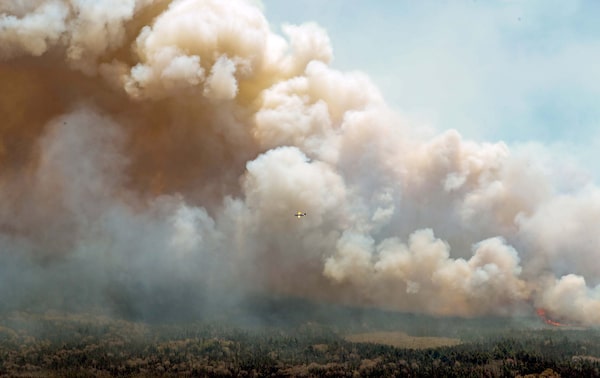
An aircraft, centre, flies near a wildfire burning near Barrington Lake in Shelburne County, Nova Scotia, on Wednesday, May 31, 2023.HO/The Canadian Press
A federal scientist with the Canadian Forest Service is pointing to the driest conditions since the Second World War as a key factor behind the largest wildfire in Nova Scotia in the past century.
Sylvie Gauthier said in an interview Friday a review of records indicates the 235-square-kilometre fire in Barrington Lake that swept over bogs, fields and woodlands in southern Nova Scotia had the fourth highest rating for dryness of the woods since 1900, and the highest since 1944.
The province’s Department of Natural Resources says the fire, which forced 6,000 evacuations and destroyed 60 houses and cottages, was Nova Scotia’s largest wildfire since the early 1920s when it began keeping records.
Gauthier said the measurement of the dryness of the fuel in the forests is referred to as a “drought code,” and is a component of the Canadian forest fire behaviour system.
“On the date (May 27) when the fire was already ignited, the drought code was the fourth highest since 1900 and it’s the highest that was seen since 1944. So, I’ll just say that the fuel was really, really dry,” she said.
Gauthier said the extreme dryness, along with coastal winds, may have enabled the fire to burn through the roughly 17 per cent of Crown lands rated as “wet” trees, and to burn or move across fields and bogs that make up about a quarter of Crown land in the area.
Anthony Taylor, a forest ecologist at the University of New Brunswick, said in an interview Thursday that up until the recent fires, there had been a downward trend in the Maritimes in wildfires over the past century due to firefighters’ growing ability to extinguish such blazes.
But he also cited recent research papers indicating climate change is expected to increase average temperatures by several degrees in the next three decades, creating an increase in the number of days each year when fires are more likely to break out in the eastern forests.
In particular, he references 2018 work by forest fire ecologists, including the University of Alberta’s Mike Flannigan, which note the trend over the past 57 years nationally is for the fire season to start “approximately one week earlier and end one week later.”
Taylor said more study is needed to definitely show that climate change is directly linked to the size of the Shelburne fire because the biggest variable remains the potential human influence in its cause.
However, he added, “climate change is increasing the number of fire weather days across the country, including in eastern Canada. This means an increase in the number of days each year conducive to supporting fires, and this is projected to get worse.”
Gauthier said projections she and other scientists prepared for the frequency of fires in the region, known as the eastern temperate zone, still suggest large fires will be rarer than in other regions of Canada.
But the measurements of the number of years between the fires is falling sharply under scenarios where the world pumps out more carbon emissions. In the more extreme carbon emission scenario studied, the “return interval” of fires goes from about 3,000 years in the 2011-2014 period to 830 years by 2071.
Forest ecologist Donna Crossland has studied the impact of fires and insect disturbances on Nova Scotia forests, and said she is alarmed by the trends.
She said in a recent interview that during the time of European colonialization of the province — before modern firefighting — large fires were more common in the eastern forests. The retired Parks Canada manager points to historical research from diary entries and letters indicating that in the 1700s and 1800s there were extremely large fires in Nova Scotia that have largely been forgotten.
She said the early fires, likely linked to land clearing by settlers, left large amounts of the wilderness with degraded soils and smaller trees with branches closer to the ground, which are better able to “carry the flame.”
Crossland said in the pre-settlement woodlands, referred to as the Acadian forest, there was a wider mix of species before widespread burning and heavy harvesting took place. The taller trees created a darker and more shaded environment, she added.
“Fires like the one we just had would have been an extremely infrequent part of our ecosystem (before European settlement), because we had those shady, humid, dark forests for the most part,” she said.
She said before the fire, her greatest fear was focused on the overharvesting of forests, but now she worries that harvesting and historic burning have combined to make the Acadian forest more fire prone, while also vulnerable to pests and hurricane damage.
“Life is going to get harder here if we don’t maintain our forest cover and allow our forest to become old again, as old as we can get them to be,” she said.